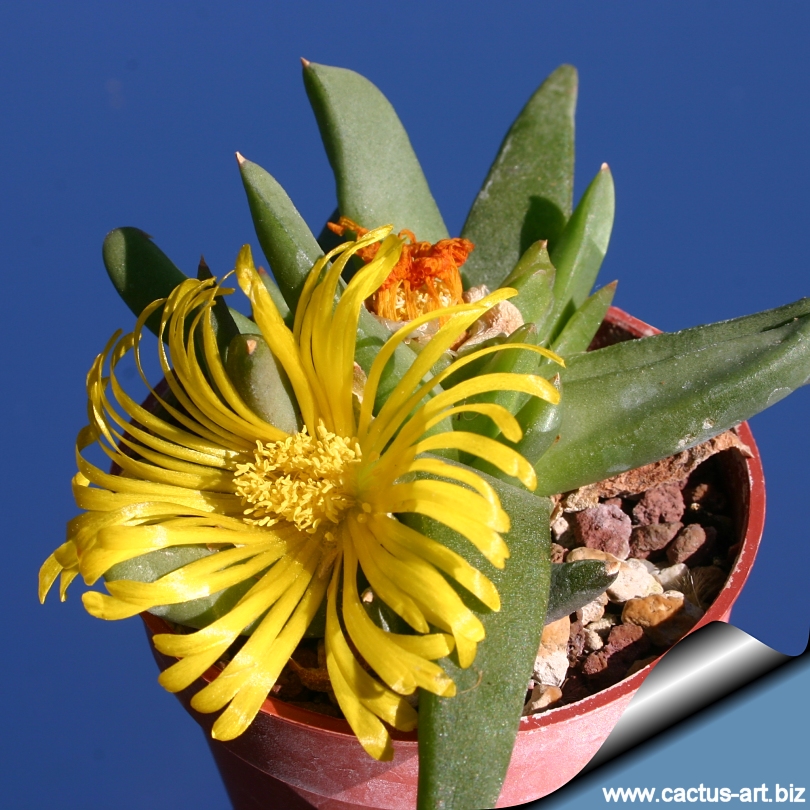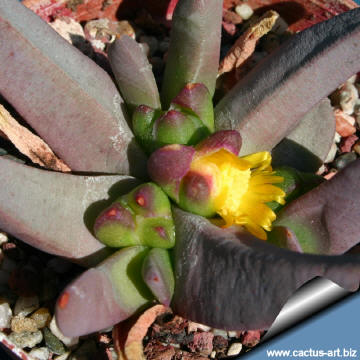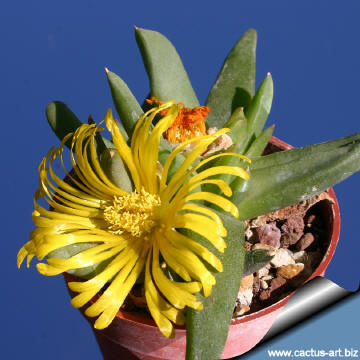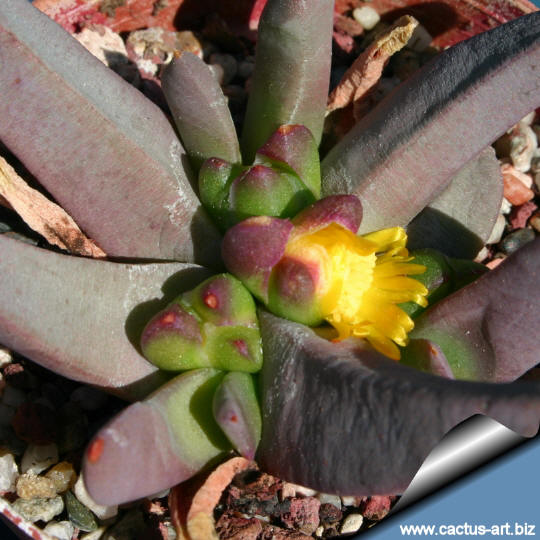|
|
|

Glottiphytllum aff. flavum SL84-357 16 k sw Laingsburg
The flowers are a very cheerful yellow daisy flower, and
the following seed pods are really cool.
|
|
Description:
Small, compact, very succulent, prostrate,
clump-forming plant that forms whorls of waxy green leaves up to 10 cm
in diameter (but often more in cultivation). There are indeed marked
differences in sizes of leaf and flowers in plants from different
population and also the growing condition (especially sun exposure)
determine differences in habit of cultivate specimens.
Stem: Almost stem less.
Leaves: In 2 to 4 ranks, equal or moderately unequally
tongue-shaped, tapered to to a sharp point, soft, glossy, light
absorbing, and dark-green to waxy grey.
They are succulent and very juicy in texture, reminiscent of gummy
bears, in full sun they assume a purplish colouring
Flowers: Bright yellow, large (4-8 cm in diameter), daisy-like,
scented and very showy. They are clustered near the centre of the
rosette. They are self-sterile, which means that you need different
plants from the same location to obtain seeds.
Blooming season (Europe): The conspicuous flowers come
mostly in lat Autumn through to late in winter. Note:
The 50 or so species of this South African genus of succulents are so
similar that many may be hybrids.
|
|

The flowers of this species are scented. |

Buds are are clustered near the
centre of the rosette. |
|
 |
 |
|

 |
|
Advertising
|
|
|
|
|
Family: Mesebrianthemaceae (Aizoaceae)
Scientific name: Glottiphyllum
suave N.E.Brown 1928
Origin: Native of the drier areas of the
Cape (South africa)
Habitat: Grows in a region that consists
of flat plains or gently rolling hills - that seem to just go on for
miles in every direction - completely covered with small sandstone
fragments of quartz atop rocky soil.
Some plant in habitat have scars or burst in their skins, just like they
do at home.
Conservation status: Listed in
CITES appendix 2.
Common Names include: Tounge-Leaf
Etymology: The name is from the ancient Greek
"γλωττίς" (glottis)
, Tongue, and "φύλλον"
(Phyllon), leaf, The
name implies "shaped as a tongue" .
|
|
|
|


They are often
grown because of their irresistibility to be touched. People cannot walk
past them without giving the leaves a gentle squeeze.
Cultivation: The plants in this genus
represent some of the more easily cultivated succulent species ;
These plants grow on winter rain and were heading for
spring-summer dormancy. Requires little water otherwise their epidermis
breaks (resulting in unsightly scars).
Water moderately from the middle of summer
to the end of winter, and keep the compost almost dry when the plants
are dormant. Water minimally in spring and
summer, only when the plant starts shrivelling (, but they will
generally grow even in summer if given water) In areas prone to frost,
grow in an intermediate greenhouse or conservatory, in pots of cactus
compost, obtainable from good garden centres. Keep cool and shaded in
summer, but provide maximum light the rest of the year.
Propagation: Seeds or cuttings. Seeds
can be sown in early to mid-spring and germinated in heated humid
environment. Alternatively, use stem cuttings taken towards the end of
summer in an heated propagating case (15-21°C)
|
|